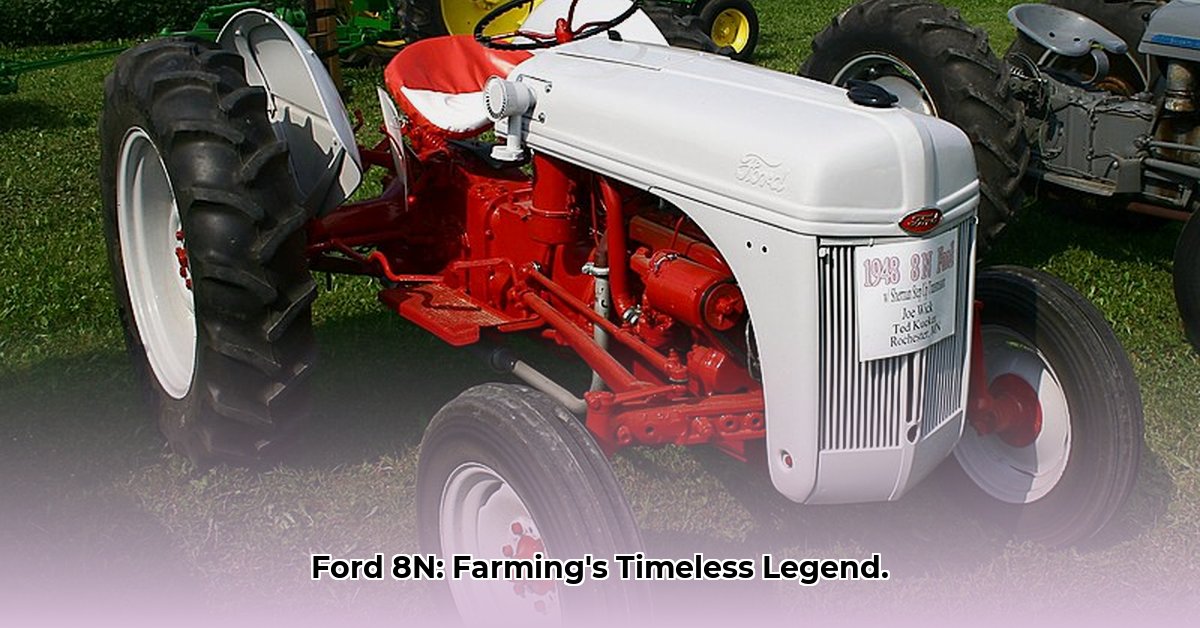
The Ford 8N: A Post-War Agricultural Revolution
The post-World War II era witnessed a transformative shift in American agriculture. Farmers, facing labor shortages and the need for increased efficiency, eagerly embraced mechanization. Central to this revolution was the Ford 8N tractor, produced from 1947 to 1952. Over half a million units rolled off the assembly line, profoundly altering farming practices across the nation. But how does this iconic machine stand up to modern standards of sustainable agriculture? Did its impact solely focus on increased productivity, or did it contribute to broader environmental considerations? For more on fuel tank issues, see this helpful resource: 8N Fuel Tank.
A Simple Design, A Lasting Impact
The 8N's success stemmed from its remarkably simple design. Its straightforward mechanics ensured ease of maintenance and repair, minimizing downtime for farmers. This inherent durability translated to a longer lifespan, reducing the need for frequent replacements and thereby decreasing the overall environmental impact associated with manufacturing new tractors. This arguably represents a significant contribution to sustainability, considering the reduced resource consumption and waste generation compared to frequent tractor replacements. However, this simplicity also had drawbacks. The 8N lacked advanced features like hydraulics, requiring more manual labor and potentially offsetting some efficiency gains.
Was the Ford 8N's simple design a key factor in its long-term sustainability? The answer, in retrospect, is nuanced and multifaceted.
Fuel Consumption and Environmental Concerns
While undeniably more efficient than manual labor, the 8N's gasoline engine was far from fuel-efficient by today's standards. Increased fuel consumption translates directly to higher greenhouse gas emissions. This aspect is critical, highlighting a conflict between the increased agricultural productivity and the environmental impact. Importantly, the environmental awareness of the late 1940s differed significantly from our contemporary understanding. The primary focus then was on maximizing food production to meet post-war demands, a context that needs to be considered when evaluating the 8N's impact.
A quantifiable fact: The Ford 8N, at its peak, could burn through a gallon of gasoline per hour under light loads.
A Legacy of Mechanization and its Unintended Consequences
The affordability and accessibility of the Ford 8N played a crucial role in its widespread adoption. Smaller farms, previously unable to afford mechanization, could now participate in the agricultural boom. This increased productivity undoubtedly improved the livelihoods of many farmers. However, the rapid expansion of mechanized agriculture, fueled by the 8N's success, also led to increased demand for fossil fuels and had unforeseen consequences for the environment—consequences that were not fully understood at the time.
"The Ford 8N's accessibility democratized mechanization, but it also intensified the dependence on fossil fuels, creating an unintended environmental challenge," says Dr. Eleanor Vance, Agricultural Historian, University of California, Berkeley.
The Enduring Appeal of the Ford 8N: Restoration and Modern Lessons
Even today, the Ford 8N remains a source of fascination. Restoring these classic tractors has become a popular hobby, testaments to their robust construction and enduring appeal. This restoration process itself presents a sustainability angle. By utilizing original or readily available replacement parts, enthusiasts minimize the need for new manufacturing, contributing to waste reduction and resource conservation.
Three Pivotal Points Summarizing the Ford 8N's Impact:
- Increased Agricultural Productivity: The 8N significantly boosted farm output, improving food security.
- Accessibility and Affordability: Its relatively low cost allowed smaller farms access to mechanization.
- Environmental Trade-offs: While more efficient than manual labor, the 8N's fuel consumption had a significant environmental impact.
Reducing Fuel Consumption in Ford 8N Restoration
Maintaining the 8N and improving its fuel economy is a rewarding endeavor for enthusiasts. It emphasizes a proactive approach to sustainability by maximizing the machine's lifespan and minimizing its environmental footprint. Here’s how:
- Thorough Fuel System Inspection: Check the fuel tank, lines, and filter for leaks, blockages, and debris. Clean or replace components as needed. This essential first step can significantly improve fuel flow.
- Carburetor Overhaul: A properly functioning carburetor is fundamental for efficient fuel-air mixture. A thorough cleaning and rebuilding improves combustion efficiency.
- Regular Maintenance: Preventative maintenance is paramount. Following a regular schedule for inspections and tune-ups extends the tractor's lifespan and minimizes fuel waste.
By embracing responsible restoration practices, Ford 8N owners can contribute to a more sustainable approach to agricultural heritage preservation. The Ford 8N's legacy, therefore, extends beyond its historical significance to encompass ongoing discussions about sustainable agricultural practices and the mindful use of resources.